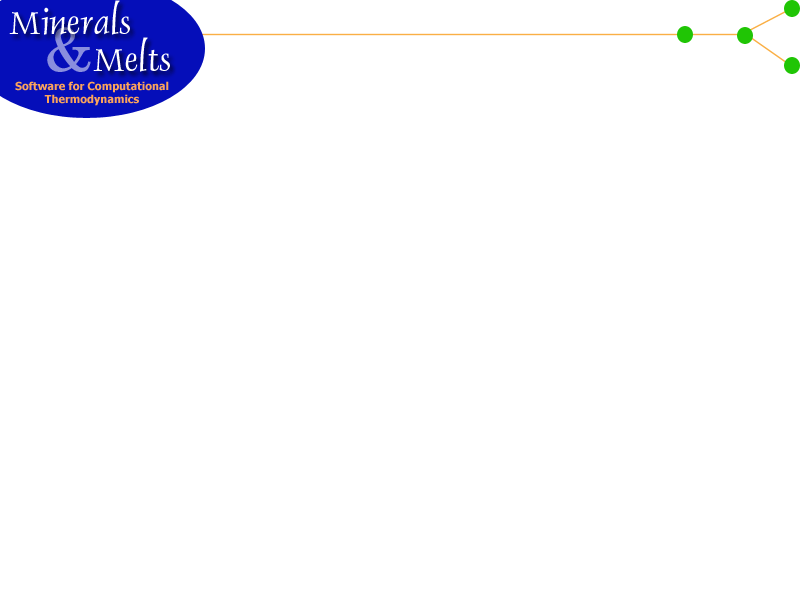Using MELTS to calculate an Isobaric, Equilibrium Crystallization Model with oxygen fugacity constrained to follow a known buffer
This example demonstrates how to do a simple equilibrium crystallization model using MELTS.- Start MELTS:
- Type the composition of the following olivine tholeiite into the text entry fields of the liquid composition panel.
SiO2 48.21 TiO2 1.70 Al2O3 15.23 FeO(T) 10.00 MgO 8.72 CaO 11.51 Na2O 2.29 K2O 0.20 H2O 0.10
This is done by clicking in the white box to the right of SiO2 (use the left mouse button to select the box) and typing the weight % value:. The delete key, arrow keys and mouse may be used to edit the ty ped value.
Typing a return advances the text entry cursor to the next oxide. Continue entering the composition until the liquid composition display panel looks like:
- Now that the composition has been entered, the temperature and pressure constraints must be specified. Using the mouse, pop down the intensive variables and release the mouse button of the T,P... me nu entry. Fill in the white text entry panels to look like this:
The starting temperature is a guess for the liquidus temperature of this olivine tholeiite bulk composition. The stopping temperature is the final temperature of the model. The temperature increment is the model increment. Results will be displayed and output to disk every increment from start to finish. The starting and stopping pressures are set equal to each other so that the model evolution path is isobaric. The pressure increment may be left blank. In this example the dP/dT gradient is zero and needn't be input.
- Before the liquidus temperature of the system may be calculated, the ferric/ferrous ratio must be specified. Because only the total FeO was given as input, this requires a model assumption regarding the oxidation state of the magma.
To impose an oxygen fugacity equivalent to the Quartz-Fayalite-Magnetite buffer at the starting temperature and pressure, select the f O2 Constraint entry of the Intensive Variables menu and while depressing the left mouse button, slide the mouse to the right and down and release on the Q-Fa-Mt constraint buffer entry.
Next, go to the Composition menu and select the Compute Redox State entry. The Fe2O3 and FeO quantities displayed in the liquid composition panel should change to reflect a ferric/ferrous ratio appropriate to the QFM buffer for a hypothetical liquid of the bulk composition displayed at the starting T and P entered above.
The f O2 constraint will be left set to QFM which will keep the ferric/ferrous ratio displayed in the liquid composition panel consistent with the QFM buffer as the system crystallizes.
- The liquidus temperature of the system is computed by selecting the Find Liquidus entry of the Commands menu. MELTS should iterate on the system temperature until the liquidus is located. Progress of the iteration is reported in the status display panel. The calculated liquidus temperature is assigned to the starting temperature of the system. The phase which first appears on the liquidus is indicated in the solids display panel. It's the one with the near-zero chemical affinity.
- At this stage the initial conditions and reaction path constraints have been specified. The crystallization model is initiated by invoking the Exceute/Halt entry of the Commands menu.
Modeling results are output to the display and to a number of disk files. For information on display elements (including graphs) consult the manual page.
The model may be halted at any time by invoking the Execute/Halt entry of the Commands menu. The user may change bulk composition or model constraints and restart the calculation using the same menu entry.
A manual page describes many common numerical problems that may occur when the program is running.
- Exit the program by invoking the Exit entry of the Commands menu.
